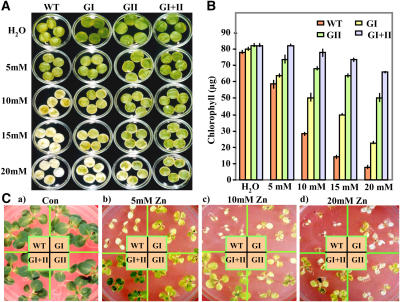Figure 2.
Retardation of zinc promoted senescence in transgenic tobacco plants overexpressing glyoxalase I (GI), glyoxalase II (GII), or both glyoxalase I and glyoxalase II in double transgenics (GI + II), indicating the tolerance at cellular levels toward toxic levels of zinc. Representative image showing phenotypic differences (A) and chlorophyll content (B; μg g−1 fresh weight) from zinc-treated leaf discs of wild-type and various transgenic plants (GI, GII, and GI + II) after incubation in 5, 10, 15, and 20 mm solutions of ZnCl2 for 5 d are shown. Discs floated in water served as the experimental control. The sd in each case is represented by the vertical bar in each graph (n = 3). Note the difference in retention of chlorophyll in wild-type and transgenic plants. C, Zinc tolerance test of representative T1 generation tobacco transgenic seedlings overexpressing glyoxalase enzymes. Seven-day-old seedlings were transferred to 0.5× Murashige and Skoog medium supplemented with various concentrations of zinc and grown for 25 d. a, Control seedlings grown on 0.5× Murashige and Skoog medium; b to d, Seedlings grown on 5 mm, 10 mm, or 20 mm ZnCl2-supplemented medium, respectively. WT, Wild type; GI, glyoxalase I; GII, glyoxalase II; GI + II, double transgenics. Note that the wild-type seedlings show chlorosis and arrested growth under high zinc conditions.

